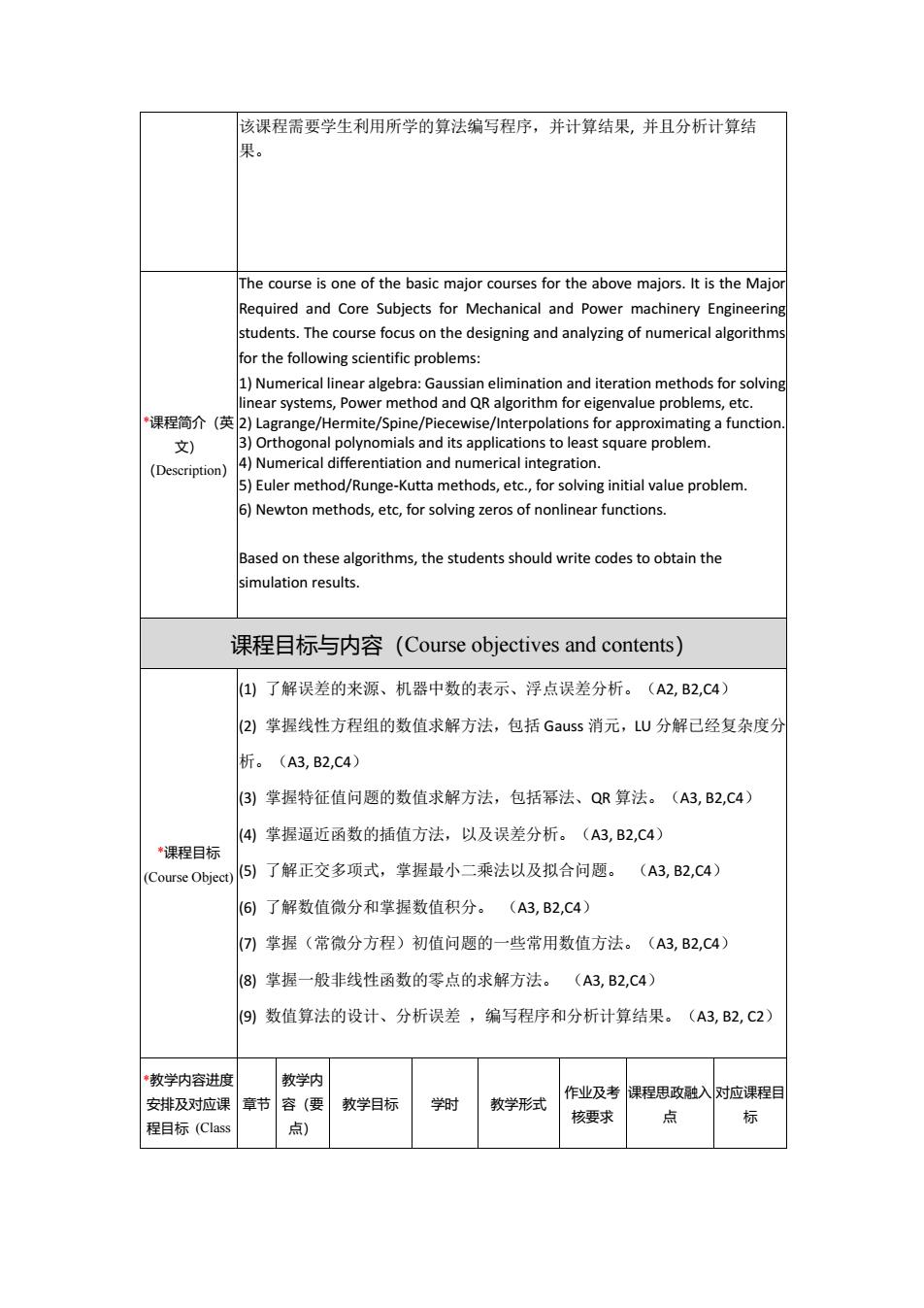正在加载图片...

该课程需要学生利用所学的算法编写程序,并计算结果,并且分析计算结 果。 The course is one of the basic major courses for the above majors.It is the Maj Required and Core Subjects for Mechanical and Power machinery Engineerin students.The course focus on the designing and analyzing of numerical algorithms for the followine scientific problems: )Numericali hods for solv "课程简介(英2)Lagrange/Hermite/Spine/Piecewise/Interpolations for approximating a functior 文) 3)Orthogonal polynomials and its applications to least square problem. ()4)Numerical differen tiation and numerical integration. 5)Euler method/Runge-Kutta methods,etc.,for solving initial value problem 6)Newton methods,etc,for solving zeros of nonlinear functions. Based on these algorithms.the students should write codes to obtain the imulation results 课程目标与内容(Course objectives and contents) (1)了解误差的来源、机器中数的表示、浮点误差分析。(A2,B2,C4) (2)掌握线性方程组的数值求解方法,包括Gauss消元,U分解已经复杂度分 析。(A3,B2,C4) 3)掌握特征值问题的数值求解方法,包括幂法、QR算法。(A3,B2,C4) (4掌握逼近函数的插值方法,以及误差分析。(A3,B2,C4) *课程目标 CocO0c5)了解正交多项式,掌提最小二乘法以及拟合问题。 (A3,B2,C4) 6)了解数值微分和掌握数值积分。(A3,B2,C4) (7掌握(常微分方程)初值问题的一些常用数值方法。(3,B2,C4) (8)掌握一般非线性函数的零点的求解方法。(A3,B2,C4) 9)数值算法的设计、分析误差,编写程序和分析计算结果。(3,B2,C2 教学内容讲度 学内 安排及对应课 要 教学目标 学时 教学形式 作业及考 课程思政融入对应课程 核要求 程目标(Class 点)该课程需要学生利用所学的算法编写程序,并计算结果, 并且分析计算结 果。 *课程简介(英 文) (Description) The course is one of the basic major courses for the above majors. It is the Major Required and Core Subjects for Mechanical and Power machinery Engineering students. The course focus on the designing and analyzing of numerical algorithms for the following scientific problems: 1) Numerical linear algebra: Gaussian elimination and iteration methods for solving linear systems, Power method and QR algorithm for eigenvalue problems, etc. 2) Lagrange/Hermite/Spine/Piecewise/Interpolations for approximating a function. 3) Orthogonal polynomials and its applications to least square problem. 4) Numerical differentiation and numerical integration. 5) Euler method/Runge-Kutta methods, etc., for solving initial value problem. 6) Newton methods, etc, for solving zeros of nonlinear functions. Based on these algorithms, the students should write codes to obtain the simulation results. 课程目标与内容(Course objectives and contents) *课程目标 (Course Object) (1) 了解误差的来源、机器中数的表示、浮点误差分析。(A2, B2,C4) (2) 掌握线性方程组的数值求解方法,包括 Gauss 消元,LU 分解已经复杂度分 析。(A3, B2,C4) (3) 掌握特征值问题的数值求解方法,包括幂法、QR 算法。(A3, B2,C4) (4) 掌握逼近函数的插值方法,以及误差分析。(A3, B2,C4) (5) 了解正交多项式,掌握最小二乘法以及拟合问题。 (A3, B2,C4) (6) 了解数值微分和掌握数值积分。 (A3, B2,C4) (7) 掌握(常微分方程)初值问题的一些常用数值方法。(A3, B2,C4) (8) 掌握一般非线性函数的零点的求解方法。 (A3, B2,C4) (9) 数值算法的设计、分析误差 ,编写程序和分析计算结果。(A3, B2, C2) *教学内容进度 安排及对应课 程目标 (Class 章节 教学内 容(要 点) 教学目标 学时 教学形式 作业及考 核要求 课程思政融入 点 对应课程目 标